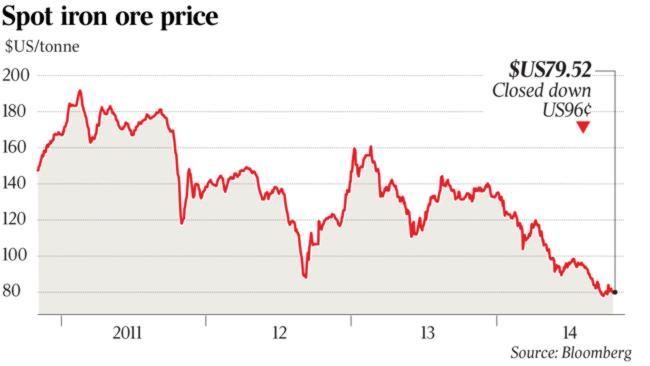Bounce in iron ore price not on the horizon
DON’T hold your breath for a quick bounce in iron ore prices.

DON’T hold your breath for a quick bounce in iron ore prices. Australia’s biggest commodity export won’t easily return to $US90 a tonne and that’s bad news for the smaller Australian iron ore miners with a higher cost of production than the major diversified miners BHP Billiton and Rio Tinto.
After hitting a record high of $US190 a tonne in early 2011, the red ore hit a five-year low near $US78 in late September. It has wallowed near $US80 since then, down almost 50 per cent year-to-date.
That’s near the cost of production for many of the smaller local producers such as BC Iron, Atlas Iron, Grange Resources and Mount Gibson, and leaves Fortescue Metals with a fairly slim margin.
Mark Pervan, head of commodity research at ANZ Bank, says his recent discussions with China’s steel mills, iron ore traders and property developers confirmed that conditions are “quite challenging”, and iron ore supply in China, the world’s second-biggest economy, has been “surprisingly inelastic”.
“China’s iron ore stockpiles remain high and its housing market is slowing at a time when the major Australian producers are ramping up supply,” he says. “There’s going to be no strong bounce above $US90 a tonne this year and there’s unlikely to be one next year either.”
About 50 per cent of the iron ore supply in China right now is not making money at $US80 a tonne, but many producers are being subsidised by the steel mills, about half of which are state-owned, says Pervan.
While his sources in China do expect iron ore mine closures to accelerate in the next six to 12 months, the subsequent loss of high-cost Chinese iron ore production is expected to be more than offset by increased low-cost supply of Pilbara iron ore from BHP and Rio.
“This is why BHP and Rio Tinto have been pretty front-footed about their expansion plans,” he says. “The loss of Chinese production will generate a positive volume effect for the Australian suppliers, but that will alleviate any price recovery. Normally when you get Australian suppliers expanding, it isn’t so aggressive, and when Chinese suppliers shut down, it pushes the price back up. That’s not going to happen this time around.”
The current tight credit conditions imposed on China’s steel mills and iron ore traders is also discouraging them from aggressively restocking at the current low prices.
Despite some seasonal increase in China’s iron ore demand, port stocks of iron ore in China are still near record highs after rising by about 70 per cent in the second half of 2013.
“China’s steel mills are currently trying to stay out of the seaborne market by buying off the ports,” Pervan adds. “Once the port stocks are run down further and China’s high-cost producers start to drop out, the steel mills will take the extra supply from BHP and Rio.”
From late November to early January, about half of China’s iron ore mining capacity will shut for the winter, enabling a seasonal bounce in iron ore, but Pervan doesn’t expect that to lift prices above $US90.
In his view, a significant rebound in iron ore is unlikely while China’s housing market remains weak, and he doesn’t expect that to recover in the next 12 to 18 months.



